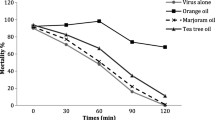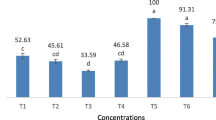Summary
Small scale field tests with a nuclear-polyhedrosis virus were conducted, for the first time in Sardinia during 1965–1966, on the larvae of the gypsy moth (Lymantria dispar L.).
Promising results were obtained by spraying the pathogen at several dosage levels on the cork-oak trees (Quercus suber L.). Mortality varied with the concentration of virus used and with the age of the larvae at the time of spraying.
In 1965 a suspension containing 1,2×109 purified polyhedra per milliliter gave 100% mortality of the second-instar larvae in 16 days. Lower polyhedra counts gave mortality ranging between 84 and 99 per cent.
In 1966 the treatments with a raw suspension containing 108 polyhedra per milliliter brought about the death, in 20 days, of 100 per cent and 93 per cent respectively of the second- and third-instar larvae. Even lower concentrations caused considerable larval mortality. The lower temperatures occurring in 1966 account for the delay in the appearance of elevated mortality rates.
Application of the virus to third-instar larvae carrying microsporidian infections (Nosema lymantriae Weiser) led to an accelerated mortality.
On the basis of the frass collected it is obvious that the insects fed poorly on the treated trees as compared to the controls.
It is not possible to make direct comparisons of dosages between the 1965 and the 1966 treatments. The different feeding activity, however, of second-instar larvae treated with similar concentrations of purified or unpurified polyhedra suggest that further research is necessary in order to ascertain if the frass reduction obtained using the raw virus suspension is not due to a greater efficacy of the unpurified as compared to the purified virus.
Field results indicate that a virus suspension containing 10 million polyhedral inclusion bodies per milliliter of water will prevent excessive defoliation of trees by the larvae.
Similar content being viewed by others
Bibliografia
Atger, P. &Vago, C. — 1960. Pathogénèse simultanée de virose et de nosémose chez les Lépidoptères. —Rev. Path. vég., Ent. agr. Fr.,39, 205–209.
Clark, E. C. &Reiner, C. E. — 1956. The availability of certain proprietary adjuvants for use with the polyhedrosis viruses of insects. —J. econ. Ent.,49, 703–704.
Glaser, R. W. — 1928. Virus diseases in insects. — In:Rivers, T.M.: Filtrable viruses. —Williams & Wilkins, Baltimore, 301–326.
Grigorova, R. — 1962. (Investigations on some diseases ofLymantria dispar andMalacosoma neustria larvae). —Izv. Inst. Gorata Bălg. Akad. Nauk., Sofija,9, 61–86 (orig. bulgaro non visto).
Huger, A. — 1960. Untersuchungen zur Pathologie einer Mikrosporidiose vonAgrotis segetum (Schiff.) [Lepidopt. Noctuidae], verursacht durchNosema perezioides nov. spec. —Z. PflKrankh.,67, 65–77.
Orlovskaja, E. V. — 1961. (Ergebnisse von Feldversuchen mit Polyederviren gegenLymantria dispar L.). —Bjull. Vses. inst. zašč. rast. (3–4), 54–57 (orig. russo).
Reiff, W. — 1911. The wilt disease or flacherie of the gypsy moth. How to aid the spread of this disease. —Buss. Inst. Harward Univ., 1–60.
Rollinson, W. D. &Lewis, F. B. — 1962. How to collect and process large polyhedral viruses of insects. —U. S. For. Serv. Ntheast Forest Exp. Sta., Forest Res. Note,130 1–6.
Rollinson, W. D., Lewis, F. B. &Waters, W. E. — 1965. The successful use of a nuclear-polyhedrosis virus against the gypsy moth. —J. Invert. Path.,7, 515–517.
Romanyk, N. — 1966. Natural enemiés of theLymantria dispar L. in Spain. —Sexto Congr. For. Mund. (Madrid, 1966), 1–2 (mimeogr.).
Rupérez, A. — 1964. Époques optima pour la prolifération de la polyédrose dans les chenilles deLymantria dispar (Lep. Lymantriidae). — Colloq. Int. Path. Insectes, Lutte Microbiol. (Paris, 1962). —Entomophaga. Mém. Hors Sér., no 2, 515–520.
Sicker, W., Magnoler, A. &Huger, A. — 1965 Über ein verzögertes Absterben von viruskranken Raupen des Ringelspinners,Malacosoma neustria L., nach Behandlung mit einemBacillus thuringiensis-Präparat. —Z. PflKrankh.,72, 599–605.
Steinhaus, E. A. — 1959.Serratia marcescens Bizio as an insect pathogen. —Hilgardia,28, 351–380.
Vasiljević, Lj. — 1958. Uticai temperaturnih kolebanja u prirodi na razvoj polidrije kod gubara. —Zašt. Bilja,41–42, 57–66.
Weiser, J. — 1961. Die Mikrosporidien als Parasiten der Insekten. —Monograph. angew. Ent.,17, 1–149.
Author information
Authors and Affiliations
Rights and permissions
About this article
Cite this article
Magnoler, A. L'applicazione di un virus poliedrico nucleare nella lotta control larve diLymantria dispar L.. Entomophaga 12, 199–207 (1967). https://doi.org/10.1007/BF02370617
Published:
Issue Date:
DOI: https://doi.org/10.1007/BF02370617




